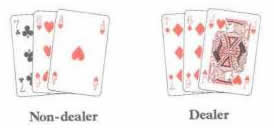Imagine two poker hands are dealt as in the illustration. The non-dealer decides to play. If he leads his ♣ 7, the dealer might spoil the first trick, and when the non-dealer follows with ♥ 6 he might spoil the second, too, but the non-dealer will win the hand with his ♥ a.

On the other hand, when the non-dealer leads his ♣ 7, the dealer’s best play is to play ♥ J, deliberately losing. He will now win the hand because, whichever of his two cards the non-dealer plays next, the dealer will beat it and win the last trick.
The non-dealer, despite having the better hand, is similarly doomed if he leads ♥ A first. The dealer will win it with ♦ 6 and then double because he cannot lose.
He plays his ♦ 7 next, and if the second poker trick is spoiled, which is the worst that can happen, the dealer will take the trick on the strength of having won the first, and thus will win the hand.
Would the non-dealer have accepted the double? Well, he could lose only if the dealer held a 7 as well as the 6 already played or an improbable three 6s.
Although the dealer, by best play, will win the hand if the non-dealer leads ♣ 7 or ♥ A, the non-dealer can be sure of winning by leading ♥ 6. If the dealer this time throws away ♥ J, the non-dealer is certain to win with his ♣ 7 on the second trick.
If the dealer spoils the first trick, he can do no better than spoil the second when the non-dealer leads ♣ 7, so the non-dealer wins on the third trick. the dealer’s best hope is to win the first trick with his ♦ 7, but whatever he leads to the second trick the non-dealer will beat and still win the last trick.
While it is generally regarded as vital to win the first trick, in order to guard against spoiled tricks, this example hand shows that this is not always so, and that there is plenty of scope for skill. And as well as the playing of the poker cards, both sides in this hand could have had decisions to make on whether to double or to accept a double on every card played.
LE TRUC FOR FOUR PLAYERS
This version is played in partnerships of two, each player sitting opposite his partner. Cards are cut to determine partners, the two highest playing against the two lowest, the lowest dealing. The deal passes to the left, as does the turn to play to a trick. one player from each side, the dealer and the player to his left (eldest) are the captains fro the hand.
Only eldest may call for a new deal, and only the dealer may refuse or accept. Neither may be helped by their partners to reach these decisions. If the dealer accepts a new deal, only he and eldest are dealt new hands the other poker players keep theirs. Eldest leads to the first trick.
A spoiled trick is one in which equally high cards are played by both partnerships. If the high cards come from the same partnership the trick is not spoiled but won by that partnership. If three cards of equal rank are highest, the trick remains spoiled, i.e. it is not won by the side which contributed two of the cards.
As before, a spoiled trick is won by the side which first wins a trick, a player winning a trick leads to the next, and a leader to a spoiled trick leads to the next. Where one side contributes equal cards to win a trick, the player who played the first of the two cards leads to the next
Only the captain of a side may double or remainder, and he must do so before his side plays its first card to a trick. Only the captain of the opposing side may accept the double or concede the hand.
When playing for stakes, it is best if partners are scrupulous about not passing information to each other in any way, but for light-hearted friendly poker games some schools allow the captain to ask his partner to lead high or low and in very light-hearted games the partner can give his captain information about his holding by various gestures (e.g. a wink for holding a 7, etc.
